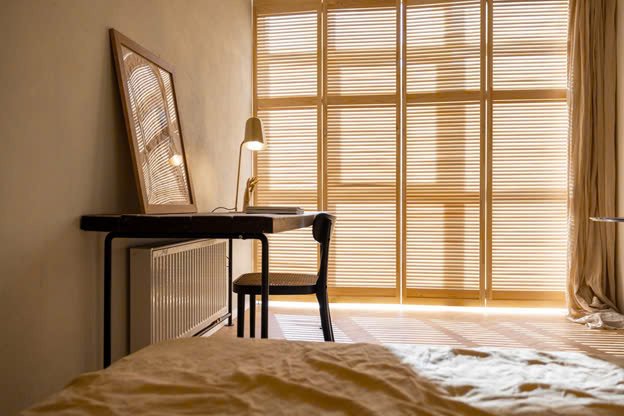Minimalist Living: How To Design A Clutter-Free Home
Embrace minimalist living with design tips for a clutter-free home. Create a serene, organized space that promotes simplicity and peace.
In an era where work, social life, and personal well-being are constantly competing for attention, adopting a minimalist lifestyle offers a refreshing approach to modern living. Young professionals, couples, and individuals living independently often find themselves navigating the challenges of small apartments, hybrid workspaces, and a fast-paced daily routine. A clutter-free home becomes more than just an aesthetic choice—it's a practical necessity for maintaining focus, reducing stress, and creating a space that fosters both productivity and relaxation.
Whether you're a busy professional looking for a streamlined home office, a couple designing a cozy yet efficient space, or an independent individual wanting to maximize your living area, minimalist living offers a tailored solution. Keep reading for tips on how you can transform your home into a sanctuary where everything serves a purpose, making everyday life more manageable, efficient, and enjoyable.
The Foundation of Minimalist Design
At the heart of a clutter-free home lies minimalist design, which emphasizes clean lines, functional spaces, and a neutral color palette. Neutral colors like whites, grays, and beiges create a calming aesthetic, while subtle colors introduced through accent pieces add warmth without overwhelming the senses. These design principles not only elevate your home's aesthetic but also cultivate a sense of harmony and organization.
The minimalist lifestyle can have many benefits beyond decluttering—it encourages intentional living, reduces stress, and helps you focus on what truly matters. Following this approach, every element in your home serves an objective, eliminating unnecessary distractions and creating a serene environment that supports your daily routines and long-term goals.
Decluttering: The First Step to a Clutter-Free Life
The decluttering process is the cornerstone of minimalist living, and it begins with a clear plan and actionable steps. These tailored strategies will help you create a clean and clutter-free environment:
Step 1: Start Small and Set Goals
Begin with a specific area, like a junk drawer, kitchen counters, or a bedside table. If you're working with limited time, the 10-minute rule is a game-changer—dedicate just 10 minutes daily to decluttering.
Step 2: Sort Items into Categories
Create three piles: keep, donate/sell, and discard. For people living alone, this is an opportunity to evaluate sentimental items and decide what truly adds value to their lives. Young professionals can prioritize high-quality items that serve multiple purposes, like a clothing steamer or a compact kitchen gadget.
Step 3: Implement Smart Storage Solutions
Once you've pared down your belongings, organize what remains. To keep everything in its place, use closet organizers, bed storage, or containers for pantry items. Meanwhile, investing in multi-functional furniture can also benefit people living in small spaces.
Step 4: Establish Daily Habits
Maintaining a clutter-free space requires consistent effort. Incorporate decluttering into your morning routine—whether it's clearing kitchen counters or tidying up a workspace. For couples, a weekly decluttering session can help keep shared spaces organized.
Meanwhile, those living alone can use this time to reflect on their clothing preferences or tackle 'worn-once-but-not-yet-dirty' articles.
Step 5: Regularly Reassess and Refresh
Decluttering is an ongoing process. Every couple of weeks, revisit your spaces to ensure they remain clutter-free. You may also need to unsubscribe from unnecessary emails and reduce digital clutter or check areas prone to accumulation, like a junk drawer or a closet clean-out. Aside from these, you may also need to assess decor items, ensuring they align with their minimalist aesthetic.
By following these steps, you can create a clutter-free and serene living space that supports your lifestyle, no matter your living situation.
The Psychological Benefits of Minimalist Living
Did you know that having a clean and orderly home can also impact your mental health and emotional well-being? Here are some of the psychological benefits of minimalism:
1. Reduced Stress and Anxiety
Clutter has been scientifically linked to increased stress levels. By contrast, minimalist spaces promote a sense of calm and order, reducing visual noise and allowing the mind to relax. When every item in your home has a purpose and a place, you're less likely to feel overwhelmed by chaos or disorganization.
2. Improved Sleep Quality
Your bedroom's cleanliness and organization play a crucial role in your sleep quality. A cluttered bedroom can subconsciously create feelings of unease, making it harder to unwind at the end of the day. By keeping only essential furniture, using soft, neutral tones, and removing unnecessary items, you can create a tranquil sleep sanctuary.
3. Greater Emotional Clarity
Minimalism encourages intentional living, which extends beyond physical possessions to your emotional and mental space. Letting go of items that no longer serve you can be a cathartic experience, helping you release emotional baggage and make room for new opportunities.
4. Financial Freedom and Mindful Consumption
Minimalism isn't just about getting rid of things—it's about being mindful of what you bring into your life. By choosing quality over quantity, you can break free from the exhausting cycle of impulsive buying and consumerism.
This shift in mindset can lead to huge savings, allowing you to put your money towards experiences and items that truly matter. Over time, this approach can reduce financial stress and help you live more intentionally.
The psychological benefits of minimalism serve as a reminder that a person's surroundings have a powerful impact on their inner life, making it a truly holistic approach to modern living.
Conclusion
Designing a clutter-free home is more than just a trend—it's a way to embrace a clutter-free and serene living space that supports your daily life. With a minimalist approach, you can eliminate unnecessary items, focus on choice items, and create functional spaces that reflect your values. Whether it's through weekly decluttering tasks or a minimalist wardrobe, the beauty of minimalism lies in its ability to simplify your life and bring peace to your surroundings.



